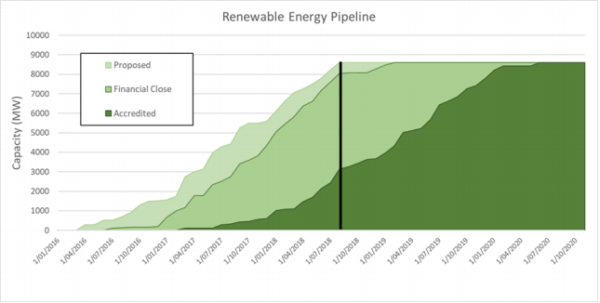“Keep up the good work” is the key message of new analysis from the Australian National University (ANU), which highlights the role of Australia’s renewable energy industry in delivering rapid and deep emissions cuts.
The ANU report shows Australia could have 100% renewable electricity by the early 2030s if the current rate of installations by industry continues into 2020 and beyond.
In their analysis, ANU experts relied on renewable energy project data obtained from the federal government’s Clean Energy Regulator, which showed Australia is likely to install about 10,400 MW of new renewable energy during 2018 and 2019, comprising 7.2 GW of large-scale solar PV and wind farms together with 3.2 GW of rooftop solar PV.

Energy Change Institute Director Professor Ken Baldwin said if the current rate of renewable energy installations continues, Australia will eclipse the 2020 Renewable Energy Target (RET) of 33,000 GWh.
“We estimate electricity emissions would thereby be reduced by 26% in 2021, and the electricity sector on its own would meet Australia’s entire Paris emissions reductions target of 26% by 2025,” said Professor Baldwin.
At the current deployment rate, the ANU analysis shows the electricity sector will be capable of supplying 29% renewable electricity in 2020, 50% in 2025 and ultimately 100% in the early 2030s.

The report notes that the estimates do not include future capacity linked to high-profile announcements of new renewable energy targets and industry trends including: the Victorian RET of 25% by 2020 and 40% 2025, including a 650 MW reverse auction to be announced soon, Queensland’s 50% RET by 2030, the Northern Territory’s 50% RE by 2030, but also Sanjeev Gupta’s 1 GW renewable energy program, the rapid uptake of C&I rooftop solar and the accelerating trend of corporate PPAs.
“All the evidence points to Australia’s capacity to be a renewable energy superpower, with all the economic and environmental benefits that come with that. We need Australia’s governments to put in place the right plans for the renewable energy train to have a smooth ride,” said Professor Baldwin.
The remaining piece of the puzzle
In addition to the right policy settings, which would allow for investor confidence in the renewable energy industry to remain strong, the ANU researchers highlight the importance of stabilization of the grid given the high levels of variable PV and wind.
The ANU report suggests the answer is a combination of storage and strong interconnection with high voltage cables to smooth out the effects of local weather and demand.
“The remaining piece of the puzzle is more storage and stronger interstate interconnection, which is where governments should be focussing their attention,” said Dr Matthew Stocks from ANU Research School of Engineering, noting that pumped hydro storage – such as the proposed Snowy 2.0 – is off-the-shelf technology, while batteries are rapidly falling in price.
The South Australia’s government, for instance, has already recognized the need for greater grid stabilization, having allocated in its 2018/19 budget $100 million for its Home Battery Scheme, the details of which were reveled on Saturday, and an additional $4 million to accelerate early works on construction of the interconnector between New South Wales and South Australia.
But, on the federal level, the haze surrounding the energy policy discussion is not getting any thiner, as anticipation of a new policy proposal continues to grow in the aftermath of the National Energy Guarantee demise.
“Our message is that the renewables train has developed great momentum, so policy makers need to get on board,” Dr Stocks underlines.
This content is protected by copyright and may not be reused. If you want to cooperate with us and would like to reuse some of our content, please contact: editors@pv-magazine.com.









By submitting this form you agree to pv magazine using your data for the purposes of publishing your comment.
Your personal data will only be disclosed or otherwise transmitted to third parties for the purposes of spam filtering or if this is necessary for technical maintenance of the website. Any other transfer to third parties will not take place unless this is justified on the basis of applicable data protection regulations or if pv magazine is legally obliged to do so.
You may revoke this consent at any time with effect for the future, in which case your personal data will be deleted immediately. Otherwise, your data will be deleted if pv magazine has processed your request or the purpose of data storage is fulfilled.
Further information on data privacy can be found in our Data Protection Policy.